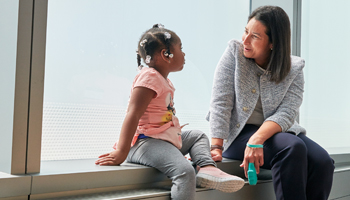HOW CAN WE HELP YOU? Call 1-800-TRY-CHOP
In This Section
Advancing Personalized Hyperinsulinism Treatment Through Discovery

Dr. De León-Crutchlow shares a moment with a patient from the congenital hyperinsulinism program
Families’ best hope for effective medical management of congenital hyperinsulinism (HI) is to access care at a center experienced in treating this rare condition, which causes hypoglycemia as a result of insulin dysregulation and has the potential to lead to brain damage and neurodevelopmental deficits.
Until 2013, Children’s Hospital of Philadelphia offered the only multidisciplinary clinical HI program in the United States. The Congenital Hyperinsulinism Center’s large patient population — 412 inpatients, 130 new patient evaluations, and 1,240 follow-ups between July 2017 and June 2018 alone — more than two decades of experience, and commitment to research continue to set the program apart.
Building on the momentum of the clinical program, Diva De León-Crutchlow, MD, MSCE, director of the Congenital Hyperinsulinism Center, saw an opportunity to expand and integrate the combined scope of the clinical and research programs under the auspices of the new Frontier Program for the Advancement of Hyperinsulinism Care and Research.
Co-principal investigator N. Scott Adzick, MD, who is also professor of Surgery at the Perelman School of Medicine at the University of Pennsylvania, and a multidisciplinary team of collaborators are working toward a future where novel ways to treat, monitor, and support young patients with HI throughout their lifespan will improve long-term outcomes. They anticipate that Frontier Program support will give rise to the discovery of new genetic forms of hyperinsulinism and broaden scientists’ understanding of disease mechanisms that will help to develop effective targeted therapies.
“My goal is that we will have a tool chest of medications and approaches to medically manage HI, so every child can receive effective treatment,” Dr. De León-Crutchlow said. “Our personalized treatment is limited by the tools we have to apply right now.”
Despite all the efforts and HI discoveries of the past 25 years, many scientific challenges remain in the field. About 50 percent of the children Dr. De León-Crutchlow cares for experience neurodevelopmental deficits. Clinicians and researchers are confounded by the 20 to 50 percent of cases in which the underlying genetic cause of hyperinsulinism cannot be identified. And medical management of HI is currently limited to one FDA-approved drug, diazoxide.
“By addressing the need for better identification of these children early on, developing tools to measure glucose continuously, and developing new therapies so every child can live without hypoglycemia, we’re hoping to reduce those neurocognitive deficits,” said Dr. De León-Crutchlow, who holds a faculty position as associate professor of Pediatrics at the Institute for Diabetes, Obesity, and Metabolism at Penn.
Integrating Care and Data
The creation of a comprehensive, multidisciplinary follow-up program for these children is a major goal of the Frontier Program, according to Dr. De León-Crutchlow. Enabling a one-day visit during which patients may see a team of specialists, instead of requiring multiple visits and appointments, is crucial for patients’ success, especially for families who live at a distance.
“We want to offer needed follow-up care that is not completely dependent on an inpatient admission because that can be challenging for families in terms of travel and from an insurance perspective,” she said.
Based on research completed at CHOP, the team has also established a process for outpatient glucose monitoring using a continuous glucose monitor. Readings may be called into the physician and finger sticks are only required when levels are too low or too high, which is a relief to patients’ little fingers.
Another aim of the program is to integrate the clinical, genetic, and research data collected into a comprehensive database.
“With the support of the Frontier Program, we are bringing in experts in analytics and data management to help us accomplish that and also create a biorepository for blood and pancreatic tissue samples,” Dr. De León-Crutchlow said. “This is going to be a fantastic resource for future discovery and long-term follow-up.”
Enabling Innovation
The Frontier Program for the Advancement of Hyperinsulinism Care will pursue continuous advancement of diagnostics and therapeutics through innovative translational research and genetic discovery.
The translational research program, created by Center founder Charlie Stanley, MD, and expanded by Dr. De León-Crutchlow has elicited innovative modalities such as fluorodopa positron emission tomography to differentiate between focal HI, in which a small part of the pancreas is affected, and diffuse HI, which affects the entire pancreas and may require near-total pancreatectomy. This has resulted in the surgical cure of hundreds of children with focal HI and successful medical management of many more with diffuse HI.
By studying pancreatic tissue and how to decrease insulin secretion in isolated cells in the lab, Dr. De León-Crutchlow and her colleagues have already validated targets in cell culture, in mouse models of HI, and in the first phases of clinical trials to study the efficacy and safety of various formulations of the GLP-1 receptor antagonist exendin-(9-39). Through industry partnerships, Dr. De León-Crutchlow hopes to develop this pharmaceutical intervention as a subcutaneous formulation as well as the basis of a radiopharmaceutical for utilization as an imaging diagnostic tool.
“With whole exome sequencing and more advanced phenotyping, we have made progress with a few new novel genetic causes we are in the process of validating,” she said. “Our experience of evaluating more than 500 kids has helped us achieve individualized treatment paths according to kids’ genetics, medical treatment response, and PET scan. It is very much personalized medicine in action.”